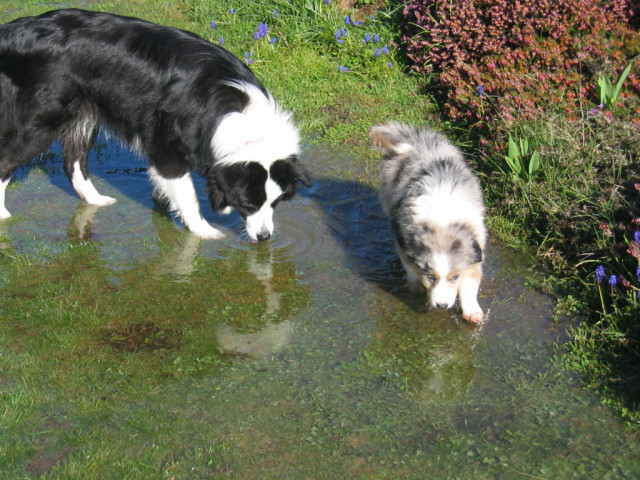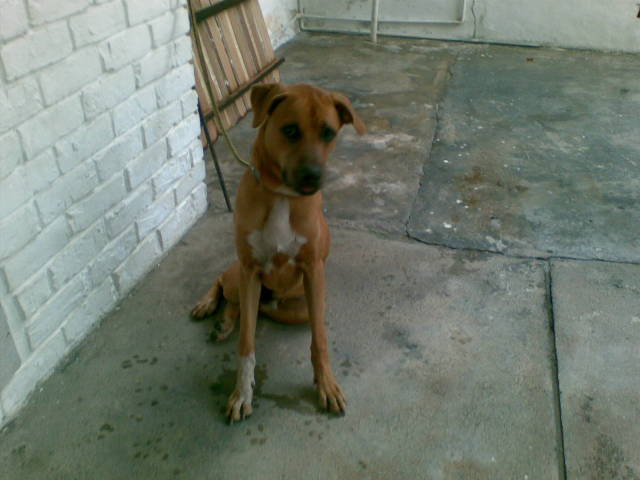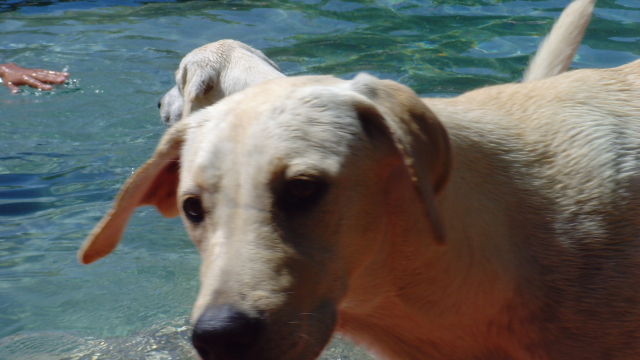QuestionI have a 3 year old yellow lab. She has always been friendly and loving with my family and guests too. However, last November she became skittish around adult strangers. When on a leash, she would shy away when an adult stranger approached us and hide behind me frantically if they tried to touch her. She's never been aggressive, and is still fabulous with my family (I have two young children). Now, this problem is getting worse. Even in my home, if a stranger or non-family member (even people she's met numerous times) come in, she's runs to the back door trying to get out and away. She's a nervous wreck. Clearly she's been traumatized, but I don't know how or when. I've had two trainers observe her, but they both want a lot of money to work with her and they don't guarentee results since it's psychological and not behavior driven. Are there any suggestions that you have on things that I can do with her to help her get past this? I should mention that she stays inside with us when we are home, but spends time outside when we are not home instead of in a cage inside. She's loves it out there and hates her cage. Please let me know what you think. Thanks!
AnswerFirst: STOP leaving your dog alone unattended outdoors. It's quite likely this situation developed at a time when she was out there. People are capable of the most heinous behaviors and often directed at animals. Leaving your dog alone, unsupervised outdoors when you are not at home is an invitation for disaster. You see the result.
Your dog has a strong conditioned fear response and it is most likely the result of outright abuse by a "stranger" that is now generalizing to all "strangers", even those with whom she is familiar. Desensitization at a very slow pace is required. While you are undergoing this effort, do NOT invite or allow any 'stranger' to attempt to touch her. Bending over a dog is a very dominant posture and can be quite threatening, especially to a dog with issues. Touch can elicit a fear response acquired when a stranger touched her in an attempt to grab her, hit her, etc., something we will never know. When a dog is presented with a feared object, the dog has three options: fight, flight, freeze. This is a biological response, it does not involve cognition: your dog is not thinking "Oh, I better get away from here", she is reacting to the biological fight/flight mechanism. On leash when she encounters a "stranger" she CANNOT run, she is thankfully not defense aggressive (although this can change) so she freezes and attempts to hide behind you. By attempting to cajole her forward (petting her, soothing her, talking to her to tell her it's ok) and forcing her to endure attempts by well meaning friends and neighbors who want to help her overcome her fear by touching her, are all making it much worse. When people enter your home, forcing interaction has made the situation worse. It's quite possible that the person who perpetrated the original act visits your home; perhaps it is a neighboring kid or even a service person (including a mail deliverer, meter reader, etc.) I suggest this because of the acquired fear response at the front door and the dog's frantic attempt to leave the house, this MAY be the result of this person having ENTERED the house.
Dog trainers are not equipped to deal with emotional and behavioral issues. Many such people have no credentials. Guarantying results is NOT IMPOSSIBLE it merely takes knowledge, which the people you've consulted obviously do not have. This is why I ALWAYS refer people to certified applied animal behaviorists. In this situation, you may be able to deal with the problem yourself BUT if it continues to worsen or the dog begins to develop a fear aggressive response, YOU NEED a professional, this is NOT an option. Just as you would take your children to a specialist should one of them develop a problem, regardless of the cost, this dog requires that level of commitment from you. I've seen dozens of dogs with front door behavior problems and fearful postures around "strangers" and almost all of those clients required just ONE visit from me. During that visit, I was able to evaluate temperament, observe the dog's response to ME (when I entered), observe the dog outdoors on leash, determine the exact moment the fear response kicks in and introduce methods of desensitization and counter conditioning that the owner(s) then proceeded to use over the course of weeks/months. There's no reason this should require multiple visits unless the dog fails and that would be due to your not following directions. In the event you find you need such a professional, a credentialed behaviorist can be found at one of these sites:
http://certifiedanimalbehaviorist.com/page6.html
http://www.animalbehavior.org/ABSAppliedBehavior/caab-directory
One of the benefits of in person evaluation is that the professional is now in a position to determine whether or not medication will assist in the process of rehabilitation. This is not something I suggest a regular veterinarian should do since these medications have side effects (which the dog cannot share with us, should the dog experience them) that can cause higher anxiety and, with young children in the home, the absolutely most appropriate drug needs to be used. Without expert evaluation, I would not encourage the use of medication.
I don't know how busy your household is, how often people visit and under what circumstances. If you have children whose friends come in and out a great deal or a busy household with many people coming and going, it's going to be a bit more difficult to address this problem since it will require 100% of your attention. DO NOT allow the dog's fear to develop any further. Unless you are present and able to observe the dog and work with her, do NOT allow her to greet people, regardless of who they are. The more exposure she has to a situation that causes anxiety, the greater the anxiety will become and possibly to the point where she develops other behaviors (separation anxiety, fear aggression, etc.) If you are anticipating a lot of visitors at once, put the dog in the bedroom with a closed door. Allow her to remain there for half an hour until the visitors have settled down, then open the door. If she chooses to come out but avoids the visitors, DO NOTHING to try to change her behavior. Visitors should avoid direct eye contact and use of her name and absolutely avoid any attempt to touch her. The aim of desensitization is to slowly disconnect what is occurring NOW to the event that conditioned the fear response. In its place, once the dog has begun to come around a bit (to the point where she will enter a room with 'strangers' in it), these people will casually (with no comment) drop tiny treats (chicken frank bits or tiny pieces of string cheese). At first the dog will be hesitant, she may not accept the 'bait' (most fearful dogs will not accept bait) but, over time (and this can happen within weeks or even days with some dogs), the dog will begin to come forward to snatch the treat (even though she might then run away with it) and slowly will begin to associate treats WITH "strangers" in the home.
Once the dog's hesitancy has markedly reduced (she clearly begins to anticipate treats with 'strangers' present), she's ready to begin to greet people SHE KNOWS WELL at the door. This will require a 'sit' to 'meet and greet'. The 'sit' needs to be well developed using only positive reinforcement training. It can be taught indoors off leash in a manner much like you will see in this video:
http://www.youtube.com/watch?v=q1W_3CDVVqo&feature=related
Thirty to fifty repetitions over the course of random training events (none of which last more than a few minutes) in a few days or a week or so will create a conditioned response to the cue (command) for 'sit'. Use a unique word and DO NOT allow your children or anyone else to cue this dog: JUST YOU and your adult partner. Once the dog responds to your cue 100% of the time, begin to use it at the front door. Put the dog on house tab (leash with handle cut off) to prevent her from running; stand on the end of the leash (rather than hold it in your hand). This will also begin to condition her to working 'sit' on restraint (leash) for outdoor work. Do a setup if possible with a friend or well known neighbor; ask the person to knock or ring the bell, take the dog to the door, cue 'sit', reward/praise, open the door. If the dog attempts to bolt, stand there and do NOTHING for a few seconds. Turn to her, cue 'sit', reward/praise until she REMAINS in 'sit', then jackpot (handful of treat) as the visitor enters. Have the visitor IGNORE the dog, stay for a minute or two, then leave. During the course of the visitors stay, observe your dog. Praise her for being relaxed and calm; if she becomes over excited or stressed, pick up the house tab, walk in a circle with her, cue 'sit', jackpot, drop leash. The purpose of this is to bring cognition into this scenario: make the dog THINK rather than react to the biological urge to run. It's a slow process if you are unable to bring people into the house for just this purpose but IT WILL eventually work.
It's extremely important, as I mentioned above, NEVER to allow the dog to repeat the experience of having 'strangers' enter the house without your strict supervision of the event. You absolutely must be able to control what the dog is thinking AND doing in order to avoid this fear response from becoming even more entrenched than it already is.
I suggest you get Turid Rugaas' book and video "On Talking Terms with Dogs: Calming Signals", found below:
http://www.dogwise.com/itemdetails.cfm?ID=DTB527
Being able to read your dog's body language (which is how dogs communicate every waking moment) is very important. You will be able to SEE the MOMENT your dog's fear response kicks in; you will then be able to STOP that moment from occurring by 'working' the dog ('sit') BEFORE it happens (something I could determine with one observation and which you CAN learn to do). In this way you will facilitate the process of rehabilitation. You will also be able to give your dog calming signals and instruct your visitors how to do so, also. Dogs observe us constantly and they DO respond to the calming signals we offer them. Interestingly, once your dog's rehabilitation is underway and you have acquired the new and handy skill of "talking dog", you will ALSO be able to identify the person responsible for this because your dog WILL TELL YOU. Once she's more accepting of visitors, that individual will STILL elicit a fear response from her, at which time you will know who to protect her (and your children) from, an important piece of information.
When the dog has gotten to the point where her fear of 'strangers' coming through your door is extinguished (which can take quite a while, the problem has been developing for almost a year), you can then begin using the 'sit' to 'meet and greet' outdoors. First you will involve friends/family (people she already knows) and then work your way up to actual strangers. The dog should be able to 'sit' 100% of the time outdoors with NO stimuli present (approaching people, dogs, etc.). This requires you re-teach the behavior outdoors, a bit harder than indoors, using a high value reward (like liver or bacon) and great patience. If the dog fails in her training, it's ALWAYS the training: stop, re-evaluate, develop more patience, continue. Developing this 'sit' in a place (outdoors) where so much is distracting is not difficult to do. You can observe it being done here:
http://www.youtube.com/watch?v=Saa13XvCdlI
In essence, the philosophy regarding dog ownership that works best for the dog is this: THIS IS MY DOG, my dog does NOT have to interact with everyone unless I CHOOSE. Just because some neighbor wants to pet my dog doesn't mean s/he DOES. Protect the dog: observe her body language (inside and out) when presented with a fearful stimulus ('stranger'), attempt to intervene BEFORE the fear kicks in but if you can't, redirect (circle left, circle right, ask for 'sit', heavily reward, continue forward), build a new association in the dog's mind between 'stranger' and herself (i.e., "I can work and earn treats when strangers are present) so that this stimulus no longer elicits fear but instead anticipation of reward. You can read Nicole Wilde's "Help for your Fearful Dog: A Step by Step Guide..." for further information and go to Dr. Ian Dunbar's site, DogStarDaily.com, for more information on positive reinforcement training and problem solving. Don't hesitate to repost with further questions, please use followup feature so I will be reminded of the problem. And please advise as you go forward in this work.

 Dog in Heat?
QuestionLily and Jorge
QUESTION: Hello,
We have
Dog in Heat?
QuestionLily and Jorge
QUESTION: Hello,
We have
 Dog light and shadow chasing
Question
Jenni
My 3 year old Cavalier King Charles Span
Dog light and shadow chasing
Question
Jenni
My 3 year old Cavalier King Charles Span
 dogs behaviour
QuestionMy 8 months old Dusto
QUESTION: My puppy
dogs behaviour
QuestionMy 8 months old Dusto
QUESTION: My puppy
 Companion for Lonley Westie
Question
Shannon
We have a 5-year-old neutered Westie w
Companion for Lonley Westie
Question
Shannon
We have a 5-year-old neutered Westie w
 Psychological trauma
Question
Izzy
I recently took my 1 year old dog to a fr
Psychological trauma
Question
Izzy
I recently took my 1 year old dog to a fr